
How to best optimize for Employee Onboarding: Assuring new hires success and longevity within an organization.
Employee onboarding is a critical process that sets the foundation for new hires’ success and longevity within an organization. How companies welcome, integrate, and support new team members during their first few months can determine whether they feel engaged, productive, and committed over the long term. Implement these best practices for optimizing the employee onboarding process.
Prepare Ahead of Time
Before a new hire’s first day, make sure their workspace is fully set up with necessary equipment, access badges, and logins to key systems like email and payroll. Send a welcome email introducing them to the team and provide an agenda outlining activities for their first week. Assign them a peer buddy who can answer questions and show them the ropes. This prep work helps the new employee dive in smoothly from day one. In addition, consider investing in Human Capital Management from Oracle to make the onboarding process easier for all involved.
Make Them Feel Welcome
First impressions matter, so roll out the welcome mat. Have the team take the new hires out to lunch on their first day. Set up one-on-one meetings with key leaders and teammates. Provide some company swag like a t-shirt or notebook. Opening gestures like these make new hires feel recognized and part of the group.
Structure a Comprehensive Onboarding Plan
Great onboarding covers a wide range of areas beyond just formal training. Develop a checklist that spans the first 90 days on the job addressing key activities, including:
– Completing HR compliance items
– Learning processes, systems, and tools
– Meeting team members
– Understanding company vision, mission, values, and culture
– Receiving individual development planning
– Gaining insight into organizational structure and politics
– Building connections across departments
Assign Onboarding Buddies
Pair new hires with peer mentors who can answer questions, provide task guidance, and facilitate connections. Buddies help newcomers navigate all aspects of working for the company, serving as a friendly face they can turn to. Routinely rotate onboarding buddies so they don’t get burned out.
Check In Regularly
Don’t just let new hires loose. Check in regularly to see how they’re doing. Set up 30, 60, and 90-day touchpoints with managers to provide feedback, ask for input, and gauge progress on ramping up. Develop a formal assessment process to evaluate areas like performance, cultural fit, and career development needs at the end of onboarding.
Promote Collaboration
Enable plenty of collaborative time for new hires to work with and get to know teammates. Assign them to cross-functional teams and projects where they can contribute fresh ideas. Set up co-working and social time for bonding with peers. Interaction, inclusion, and a sense of community keep engagement high.
Encourage Knowledge
Sharing Make it easy for new hires to tap into existing employee knowledge. Create forums for asking questions and sharing best practices. Maintain wikis with guidelines, how- tos, and organizational info. Enable informal mentorships and job shadowing. This access to tribal knowledge prevents new hires from reinventing the wheel.
Provide Ongoing Training
Classroom training during onboarding should be just the start. Offer supplemental learning opportunities through online classes, reference materials, on-the-job coaching, and more. Continuous training allows new hires to further develop critical skills over time.
Gather Feedback
Solicit new hire input at multiple points during onboarding, such as 30-60-90 day surveys. Ask what’s working well and what could be improved in the process. This shows you value their opinions and helps enhance the experience for future new hires.
Onboarding done right is an immersive, supportive experience. Following structured best practices helps employees get up to speed faster, gain confidence in their abilities, and start contributing sooner to meet organizational goals. The payoff is a stronger talent bench and a more engaged, productive workforce.







